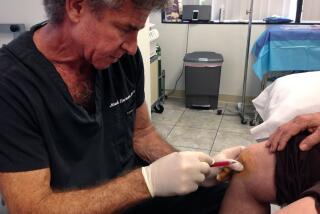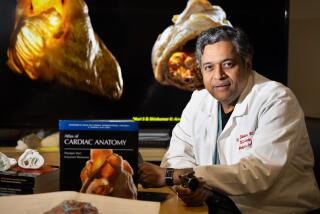Column: How Jack Nicklaus and Dr. Sanjay Gupta hyped an unproven stem cell treatment — and why this could harm you
The report published April 27 on CNN.com had a glittering pedigree. It was co-authored by Dr. Sanjay Gupta, CNN’s respected chief medical correspondent, and it featured a novel treatment undertaken by the world-famous golfer Jack Nicklaus for his chronic back pain.
The article reported how Nicklaus, 78, had gone from suffering “particularly debilitating” back pain after a lifetime of golf swings to feeling fit enough to play up to 25 rounds of golf this year. “How long does [Nicklaus] want to play golf?” the article asked. “’As long as my stem cells allow me,’” he replied.
That’s a potent first-hand endorsement of an experimental therapy, retailed for CNN’s readers by its most eminent medical authority.
I’m just obviously not a doctor, I’m just a layman as it relates to this.
— Jack Nicklaus
Yet rather than provide readers with useful insights into a potentially effective therapy, the piece displayed everything that’s wrong with reporting on unproven medical treatments — especially those involving stem cells. It repeated almost as gospel the representations about the treatment made by its promoters, who have a financial interest in making the treatment seem effective.
Although the piece mentioned that Nicklaus’ procedure is “as of yet, unproven,” it implied that proof is on its way. But it failed to mention that no such stem cell treatment has been approved by the Food and Drug Administration. Nor did it place Nicklaus’ treatment in the context of the proliferation of clinics pitching unproven “stem cell” treatments to desperate patients nationwide. The article failed to mention that patients undergoing purported stem cell treatments at clinics across the country have suffered dire health effects.
Gupta didn’t reply directly to my questions about his report, which was co-written with CNN producer Roni Selig. The report wasn’t broadcast on CNN but appeared on the network’s website, where it’s still accessible. But a CNN spokesperson defended the piece as limited only to “Jack Nicklaus’ story and his experience with stem cell therapy.” She added, “it was made clear in the piece that these therapies have not been proven.”
Is that good enough? The answer is no.
The promoters of bogus stem cell treatments rely on exactly the veneer of scientific legitimacy endowed by reportage like this. The fact that it carried the star power of Nicklaus and Gupta makes it much, much worse — indeed, potentially dangerous to people’s health. Their names ensured that the article’s claims would be republished and repeated widely, as they have been.
Nicklaus is a sports demigod; an entire generation of fans hang on his every word, and his implicit endorsement of a therapy could overwhelm the uncomfortable fact that it hasn’t been shown to work on a clinical scale.
“I’ve become a believer,” Nicklaus said during the panel discussion at a Vatican City medical conference that formed the core of the CNN piece. But he added: “I’m just obviously not a doctor; I’m just a layman as it relates to this.”
Gupta has tremendous credibility with CNN’s audience because he’s seen as a responsible purveyor of legitimate medical news; that makes it even more imperative that he not lend his reputation to what might well be a chimera.
“Media organizations like CNN should use extra caution when reporting on testimonials from celebrities such as sports stars about their experiences with unproven stem cell treatments,” says Paul Knoepfler, a biologist at UC Davis who has been tracking the proliferation of clinics offering stem cell treatments, “especially with all the for-profit stem cell clinics out there looking for new customers.”
Just last week, the Department of Justice and Food and Drug Administration filed lawsuits to shut down clinics in California and Florida that have been purveying unlicensed and unproven treatments to thousands of patients. The target clinics have histories of causing harm to their customers, according to the lawsuits. That, Knoepfler observes, “illustrates just how much it is a jungle out there for consumers interested in stem cells.” CNN’s report and its offspring might well prompt other patients to seek touted stem cell treatments at facilities nowhere near as credible as the place Nicklaus received his care.
There are other problems with Gupta’s report. Let’s examine them.
Start with how the report came to be in the first place. Gupta was invited to participate as a moderator at the healthcare conference sponsored by the Vatican in Vatican City from April 26 to 28. The conference lineup was a curious melange of creditable scientists and not-so-creditable figures, including Dr. Mehmet Oz, an energetic purveyor of unproven medical nostrums to his huge audience; Deepak Chopra; Tony Robbins; and Richard K. Burt, a Northwestern University stem cell scientist who has received blistering criticism from the FDA.
Among the panels Gupta moderated was one featuring Nicklaus; Eckhard Alt, the doctor who treated him with stem cells; and two representatives of Sanford Health, a South Dakota hospital chain performing clinical trials of stem cell treatments for orthopedic conditions. Gupta’s exchange with Nicklaus during that panel formed the core of his CNN report.
What may not have come across in his article, however, was that the Sanford Health researchers were rather circumspect at the conference about their findings from the key trial, which involves injuries to the rotator cuff, a part of the shoulder. The trial had 18 subjects, of whom 12 received stem cell injections. The trial was aimed chiefly at establishing that the procedure was safe. (Nicklaus was not part of the trial.) Sanford will shortly be recruiting more than 100 patients for the next phase of the trial, aimed at producing evidence of whether the procedure is effective in regenerating injured tissue.
Jason Hurd, the lead researcher on the trial, acknowledged at the Vatican conference that the research is at an early stage. “We don’t have a lot of clinical research bringing the laboratory side into patient care,” he said. “We need to see a lot more clinical studies.”
Mark Lundeen, an orthopedic expert at Sanford, said that some of the patients in the trial have shown an improvement in the range of motion of their rotator cuffs and report pain relief. But he acknowledged that since the 12 subjects knew they were receiving stem cell treatment, “by definition, there’s a placebo effect.… If a patient knows they’re getting an injection of stem cells and you ask them later, does your arm feel better, the natural tendency in medicine is for them to say, ‘For sure, I feel way better.’”
These caveats weren’t mentioned in Gupta’s report.
The CNN article mentioned that Nicklaus’ procedure was performed at ISAR Klinikum, a Munich hospital, by Alt, whom the piece identified as a “German stem cell pioneer.”
Gupta’s article didn’t mention that Alt, ISAR and Sanford Health are closely related, or that at the heart of the relationship is a for-profit corporation hoping to win FDA approval for a medical device that isolates stem cells for re-injection into the body. These connections might well have influenced the treatment choice for Nicklaus.
Alt is the founder of ISAR Klinikum. He also is a faculty member at Sanford Health. The clinical trials at Sanford are aimed at validating a device to isolate stem cells from liposuctioned fat, which was evidently used in Nicklaus’ treatment.
The device is manufactured by Ingeneron Inc., a Houston biotech firm of which Alt is founder and chairman. Ingeneron received a $20-million investment last year from Sanford Health. Sanford Health’s president and CEO, Kelby K. Krabbenhoft, is a member of Ingeneron’s board of directors. Sanford Health also is an investor in ISAR Klinikum, and Krabbenhoft also has been named to ISAR’s board. None of these relationships is illegal, and all have been the subject of public disclosures.
Nicklaus met Alt for the first time at a birthday party in 2015 for Denny Sanford, a South Dakota banker and philanthropist who is a friend and associate of the golf icon, including through their charitable interests. Sanford Health was named for the banker after he made a $400-million donation in 2007 to what was then Sioux Valley Hospitals and Health System.
The CNN article says Alt “considered all options for the famous golfer” before settling on stem cell injections as “the lowest risk way of treating him.” It might only be coincidental that the procedure Alt chose happened to be the one in which he has a financial interest and that might benefit from being associated with a world-famous athlete. But it might not be.
Neither Alt nor Nicklaus responded to requests for comment.
All signs indicate that Sanford’s research is serious and its trials well-constructed. The organization doesn’t pitch bogus stem cell treatments to patients like the clinics cited by the FDA last week, but says it limits its research to musculoskeletal conditions for which stem cell therapies may have the best chance of success.
Denny Sanford himself told me he’s concerned that “there are a lot of street-corner operators claiming that they’re using stem cells…. Anything to make a buck.” He says he’s in the process of creating an organization for “legitimate, proven” clinics with a serious approach to the science.
Gupta’s article repeated Sanford Health’s assertion that its clinical trial is “FDA approved.” That appears to be an exaggeration. “The FDA does not ‘approve’ clinical trials of any kind,” an agency spokesperson told me. “Rather we allow them to proceed.” That’s if the trials meet certain standards such as obtaining informed consent from subjects and adherence to institutional review board requirements. Potential patients might be misled by the term “FDA approved” into thinking the agency has endorsed the treatment. It hasn’t.
Gupta states in his piece, “The evidence to support Alt’s claims are [sic] still in progress, and further proof is expected from an FDA-approved clinical trial at Sanford Health in the U.S.” That implies that there’s already “proof” of Alt’s claims. But none has been published in the U.S., and Sanford Health says it’s not ready to release any findings of the treatment’s efficacy.
Gupta’s CNN piece boiled down to an implicit endorsement of the stem cell treatment by Nicklaus, whose judgment was personal and necessarily subjective. The average reader’s takeaway from the article may well be that the treatment worked for Nicklaus, and therefore is ready for prime time. The article’s lone reference to its “unproven” nature is no match for the personal testimony of a widely admired sports star.
Nicklaus at least acknowledged that he is a layman. Apparently he didn’t talk publicly about his treatment until the Vatican panel last month.
But what about Sanjay Gupta? As his network’s top medical authority, he bears paramount responsibility for making sure that his viewers and followers aren’t misled by claims that haven’t been scientifically validated. His report should have disclosed all the commercial links among the clinics and doctors it mentioned. It should have stressed more thoroughly the questions about this category of therapy and made clear to readers that the field is rife with charlatans. He fell down on the job.
Keep up to date with Michael Hiltzik. Follow @hiltzikm on Twitter, see his Facebook page, or email [email protected].
Return to Michael Hiltzik’s blog.



